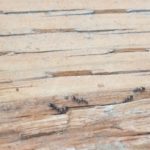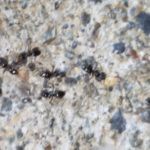Pest Control on How to prevent sugar ants from invading your home or commercial business buildings
Even if your house is already pretty clean, there are still some extra things that you can do to deter any sugar ants that may be scouting out your living space. Why using a contact killing spray is not the best idea is that it’s only getting rid of the sugar ants that you spray.
Like many people, your first reaction upon finding sugar ants in your house is to grab a can of ant spray. This is the method that most people know about, and it’s the way that our parents and grandparents usually handled their ant problems. It’s a quick fix, and it may make you feel better in the short term, it will kill the sugar ants, but the fumes are very dangerous to you, your family, and your pets. The entire area plus any ant trails that you find have to be thoroughly sprayed, but it’s basically just a band aid.
Hire Local Exterminators To Get Rid of Sugar Ants
It’s important to call in a professional extermination ant control service near you has become easier with area zip code. if you see signs of an infestation. Simply spraying a group of ants with bug spray is usually not enough to get rid of a colony.
How do I keep sugar ants out of the kitchen?
Most people think ants come from outside, and for the most part that’s true. They seek out cracks, crevices, vents, and openings to enter your home in their effort to find food and water. However, only one ant out of the thousands in a nest needs to find an entry point. Once an ant finds a food or water supply, it lays a pheromone trail for other ants to follow. Other ants live inside your house.
These ants build nests in undisturbed spaces, including in wall voids, by burrowing out soft wood or by building a nest among some unused items in a secluded area of your home.
Natural methods to get rid of sugar ants
There are many ways to eliminate ants and their colonies in the home. While Extermination exterminators may be necessary in some cases, some natural solutions can eradicate the problem without adding chemicals or toxins to your environment.
Chemical methods to get rid of sugar ants
Ants leave a scented pheromone trail behind when they walk, which acts as a map. This method can remove the scent and deter the ants from reentering your home.
How did I get a sugar ant infestation?
Keep your yard clean of debris. Cut off any vines or vegetation that touches or leans onto the exterior walls of your house and windows that can make it easier for ants to enter your home.
Ants are attracted to sweet and starchy foods like sugar, honey, and cornmeal. Therefore, one of the best ways to deter ants is to ensure that no food sources are readily available for them to eat.
Keep food tightly sealed in containers or plastic bags. Wash all plates and cooking utensils immediately after eating.
Where do sugar ants come from?
Figuring out how ants are entering your home can help you eliminate an ant infestation and prevent a future one.
Check your home for cracks in the walls and holes near floorboards and radiators. You can seal cracks or treat them with ant repellent. Also, check for rips in window screens that require mending.
How to remove sugar ant nests
Hiring an exterminator can help. Look for one who’s committed to using the least toxic products possible. Let them know if you have children, pets, or other concerns, such as a respiratory health condition.
Some Extermination exterminators use green, organic, or eco-friendly words in their titles. If you are concerned about chemicals, ask the exterminator what substances they typically use in ant treatments before you hire them.
How to Get Rid of Sugar Ants
Getting rid of sugar ants in the kitchen is important so that they stay away from your food. The first step to eliminating a sugar ant infestation is identifying if the insects you see in your kitchen are indeed sugar ants. While there are many home remedies for fire ants and other species of ants, you need to find solutions that work explicitly on sugar ants.When it comes to keeping sugar ants out of the kitchen, the ideal solution is to prevent them from arriving in the first place. Sugar ants end up in the kitchen because they are in search of food, so you can prevent an ant problem from developing by keeping a clean kitchen.sugar ants come from outside your home. They have about four to five times more odor receptors than other insects, and can smell food and follow scent trails through cracks, crevices, vents, and other openings in your home and foundation.
Ants can become a serious nuisance and may cause sanitation problems. They may bite or sting and have a nasty habit of walking all over your food without wiping their feet. In Washington, the most common invaders are pavement ants and odorous house ants. As a group, these small ants are sometimes called “sugar ants” due to their attraction to sweet foods.
Ants are social insects that live in colonies made up of one or more queens (reproductive females) along with eggs, larvae, pupae, and worker ants. The ants you see are usually workers foraging for food. The pest species listed above typically have workers that are light brown to black in color and about 1/16″ to 1/8″ long (around 2-3 mm). You may see a single, wandering “scout” searching for food, or a trail of ants between the nest and a food source. Depending on season and species, the ants may be most attracted to sweet foods or beverages, protein sources (meats and dairy foods), or grease and oils. Sugar, honey, or spilled soft drinks are common attractants.
While single ant scouts are not much cause for alarm, they shouldn’t be ignored as they will locate food sources and bring all their friends. Ant trails may involve hundreds or thousands of individuals moving back and forth and require attention immediately. Watch for ant trails along walls, under sinks and appliances, even under the edge of carpets. They may lead to spilled food or drinks, garbage cans, or stored food products.
How to get rid of Ants By Well trained Exterminators
Ants are attracted to sweets, sugar, grease, protein, and even moisture. Wipe up spills promptly, vacuum or sweep after snack time and parties, and keep sinks and counters clean! Take the trash out daily, and keep the garbage
cans clean, too.
Do you keep food in the classroom or break room? Plastic, paper, and cardboard won’t stop ants. Store food in clean, closed containers with tight-fitting lids
Ants are small – they don’t need a lot of food, so a crumb or a drop is enough for a feast. Soft drink cans and soiled food containers are very attractive to foraging ants, so wash with soapy water or rinse thoroughly before tossing them in the recycle bin.
Pets or potted plants in the classroom? These can be attractive to ants, too. Plants can become infested with aphids or other honeydew-producing pests, and pet food debris can be an ant buffet. Monitor these attractive situations to prevent problems.
Ants on the move. If you see a few stragglers wandering through the classroom, you may be seeing the scouts for an ant invasion. Wipe them up with soapy water and a sponge and get rid of them before they report back to the nest.


If you see trails of foraging ants, report them! Trails can be mopped up, vacuumed, or cleaned with soapy water and a sponge, but that alone may not solve the problem.
Ants Extermination
Keep ants and other pests out by sealing cracks and crevices around windows, doors, wiring, plumbing and foundations. Seal gaps and cracks and maintain door sweeps in good condition. Since most ant pests nest outdoors, preventing access to the building is an important control measure.
Keep food preparation and eating areas clean. Rinse or wash recyclable food containers before storing. Empty trash cans daily and keep cans clean inside and out. At least once daily, wipe counters, sinks, and other surfaces that collect food debris. Store food in sealed containers with tight-fitting lids or inside refrigerators and freezers.
Regularly check pest-prone areas, such as kitchens and staff lounges, for indicators of ant problems. Moisture is also attractive to ants, so watch sinks and drains and report leaky plumbing immediately.
Wipe up individual ants with a sponge and soapy water and dispose of them. Ant trails may be wiped up, mopped with soapy water, or vacuumed.